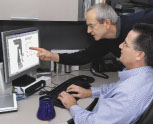Working Model 2D
2D Dynamic Motion Simulation

Anatomy Students use Engineering Software to Study the
Human Body at University of Tennessee (224k PDF)
While engineering software is commonly used to analyze and test parts
found in cars, airplanes, or other complex mechanical systems, its ability to
model continuous motion lends itself to studying motion of the human
body's joints as well. At the University of Tennessee at Memphis School of
Biomedical Engineering, graduate students in an anatomy course study the
human body's muscular and skeletal systems using engineering concepts
and a mechanical model based on visualNastran® software.
Professor Uses Working Model as New Class Problem-Solving
Tool (222k PDF)
Professor Charles Proctor, of the University of Florida in Gainesville, has
found a way to give his engineering students a more hands-on appreciation
for their work. He now utilizes Working Model, inexpensive desktop
mechanical simulation software developed by Design Simulation Technologies. The product's
intuitive interface and advanced simulation engine allows models to be created and analyzed
quickly and simply.
Working Model® Moves into School Computer
Labs (221k PDF)
Dorm rooms, cafeteria food, all-nighters...and Working Model? The
engineering student's experience at colleges across the country is taking on
a new element. Major universities like Rose-Hulman, Stanford, University of
Michigan, and others are busily incorporating Working Model as an integral
part of their academic environment.
Engineering Freshman Jump into Design at
Georgia Tech (221k PDF)
Georgia Tech Aerospace Engineering students are getting a good idea of
how interesting and complex design can be in a new Freshman Design
course taught by Dr. Kurt Gramoll. Working Model®, along with Excel, Word,
TK Solver, and MATLAB, are introduced to entering freshmen in this basic
computers-in-engineering course.
Working Model® Simulates Biomechanics at
Berkeley (221k PDF)
When humans and other animals hop or run, they literally bounce along the
ground using muscles, tendons, and ligaments to store and return elastic
energy. Past research has shown that the mechanics of these bouncing
gaits can be accurately modeled by a simple spring-mass system. The
model consists of a point mass representing the body mass of the subject
and a linear compression leg spring. This spring mass model has been
shown to accurately predict the mechanics of all running, hopping, and
trotting mammals studied to date.

 Quote
Quote Evaluation
Evaluation



